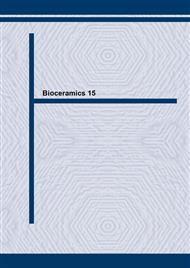[1]
KD. Kühn: Bone cements (Springer, Berlin 2000).
Google Scholar
[2]
T. Kokubo, H. Kushitani, S. Sakka, T. Kitsugi and T. Yamamuro: J. Biomed. Mater. Res. Vol. 24 6 (1990), p.721.
DOI: 10.1002/jbm.820240607
Google Scholar
[3]
H.-M. Kim: J. Ceram. Soc. Japan Vol. 109 4 (2001), p. S49.
Google Scholar
[4]
C. Ohtsuki, T. Kokubo and T. Yamamuro: J. Non-Cryst. Solids Vol. 143 1 (1992), p.84.
Google Scholar
[5]
C. Ohtsuki, T. Miyazaki, M. Kyomoto, M. Tanihara and A. Osaka: J. Mater. Sci. Mater. Med. Vol. 12 10-12 (2001), p.895.
DOI: 10.1023/a:1012876108210
Google Scholar
[6]
ISO. International standard 5833 / 2: Implants for surgery-acrylic resin cements. orthopaedic application (1992). Acknowledgements This study was supported by Grant-in-Aid for Scientific Research ((B)13450272), Japan Society for the Promotion of Science. CCCCCCCCCCCCCCCCC BBBBBBBBBBBBBBBBB BBBBBBBBBBBBBBBBB CCCCCCCCCCCCCCCCC Reference Modified cement Fig. 2. Hematoxylin-Eosin staining image of the interface between rabbit tibia and the cement modified with MPS and calcium acetate 4 w after implantation, in comparison with the control. Arrow indicates fibrous tissue. B; bone, C; cement. Control
Google Scholar


